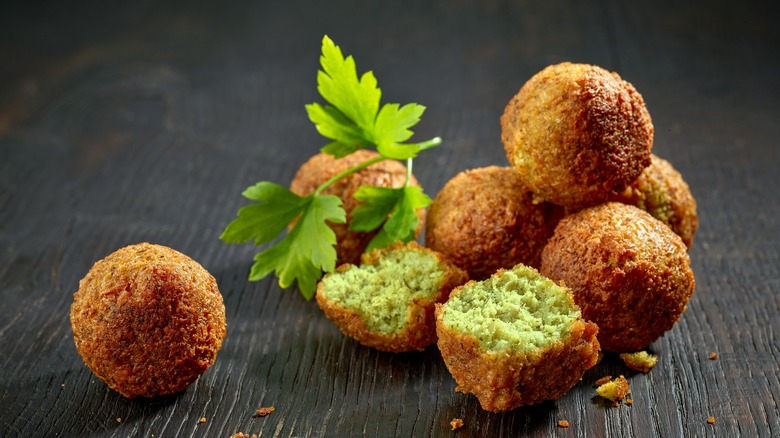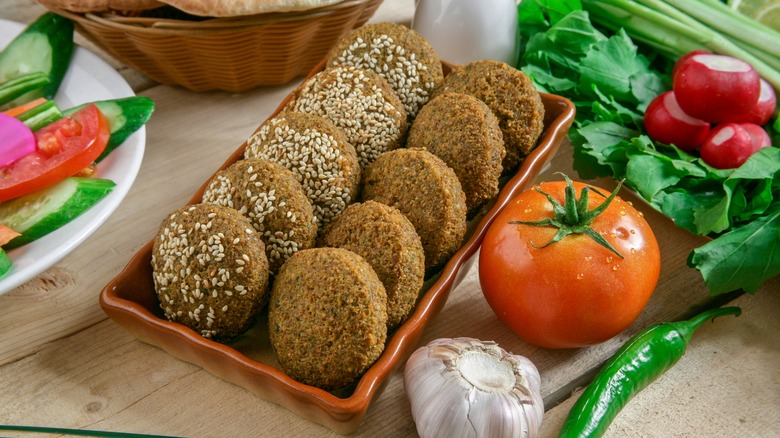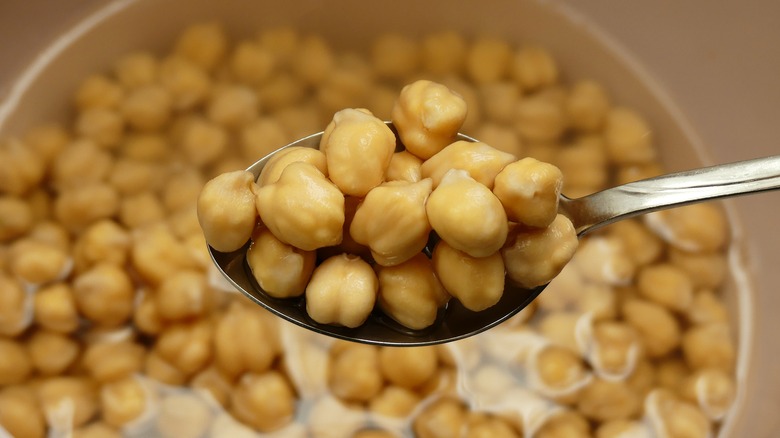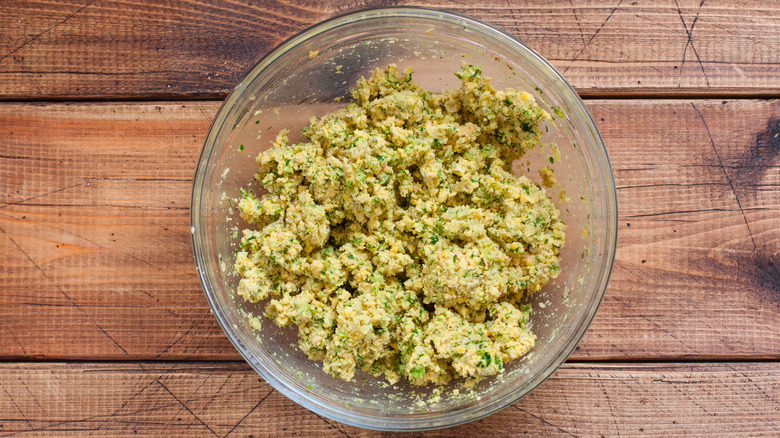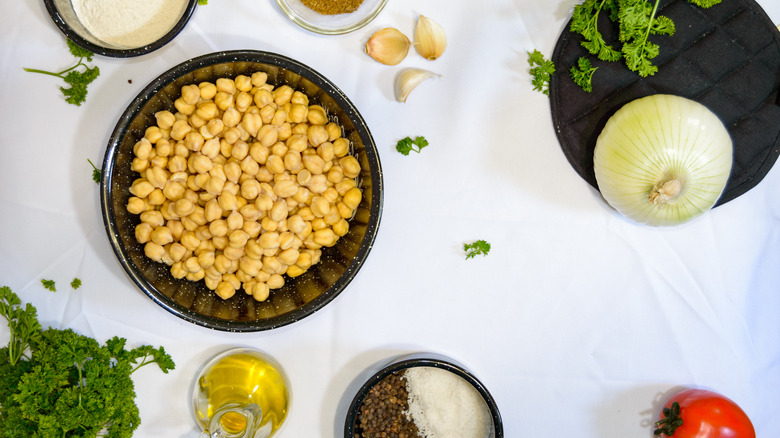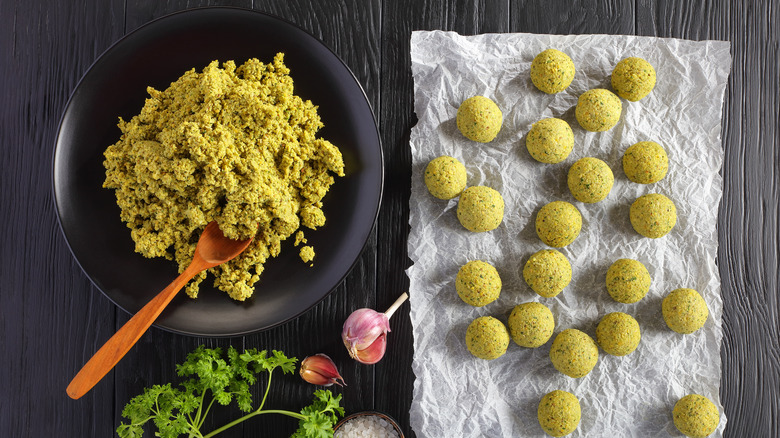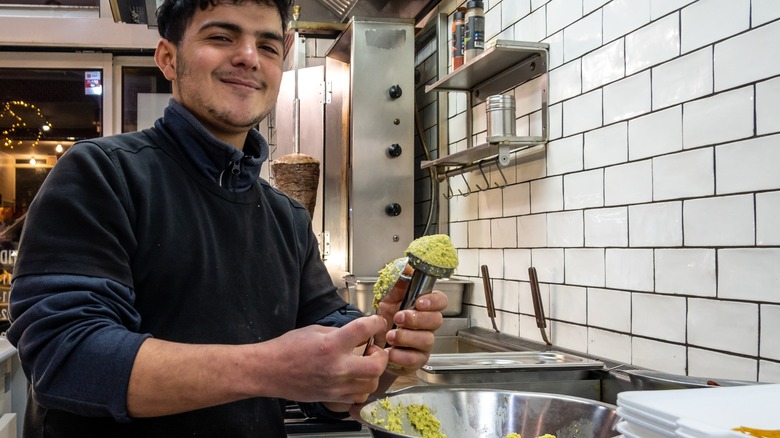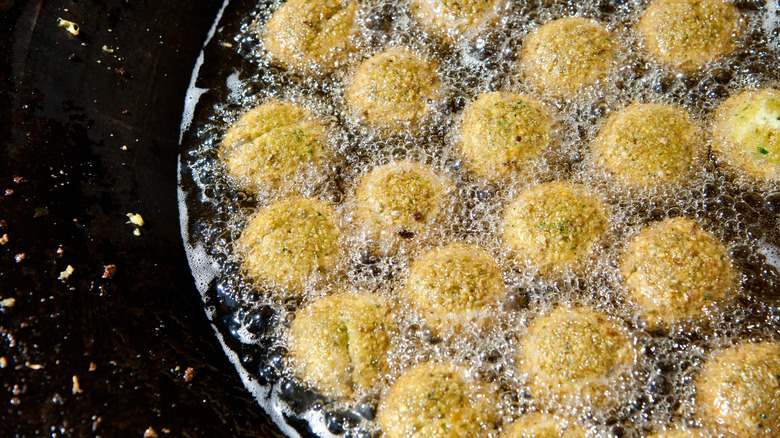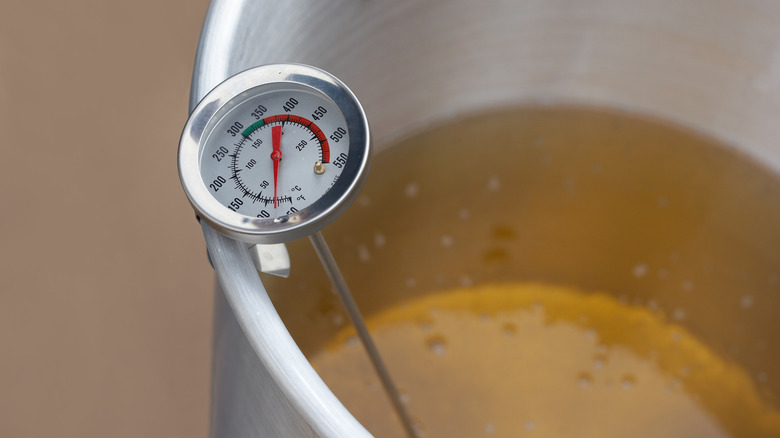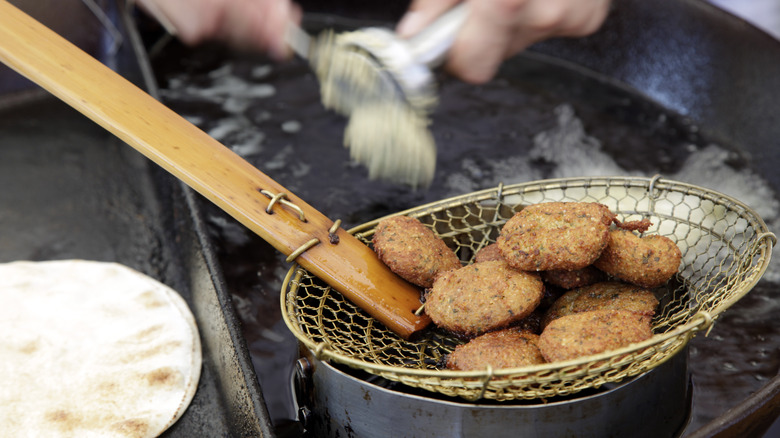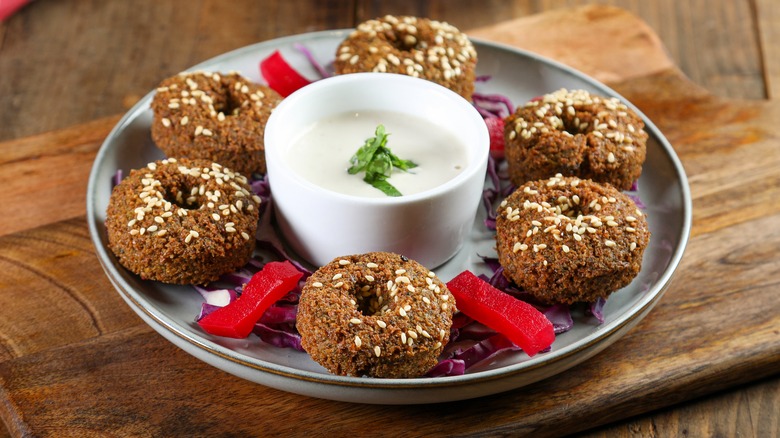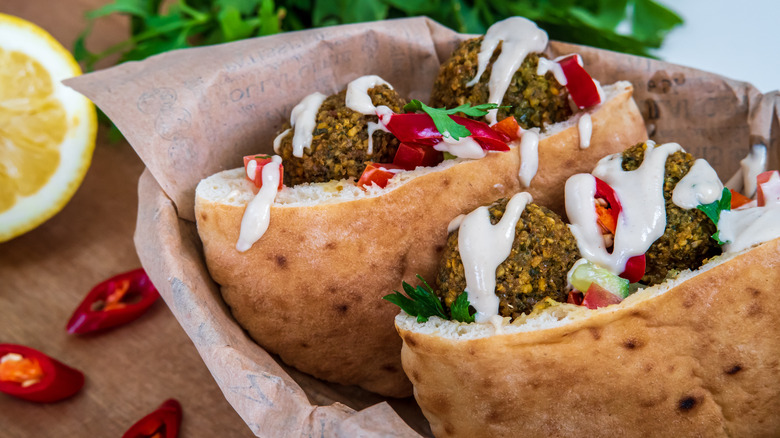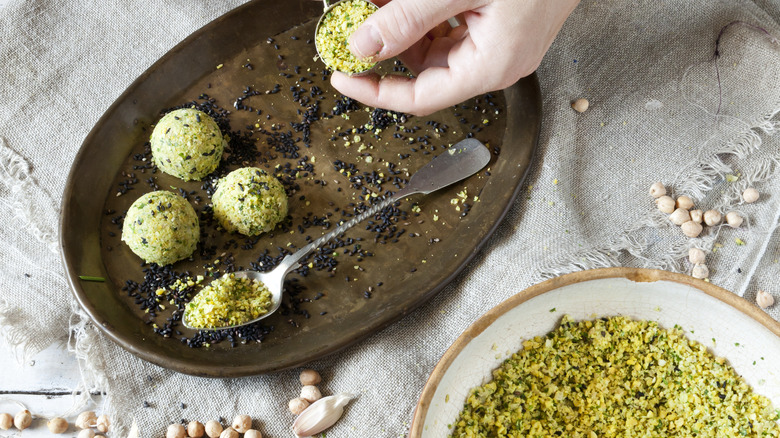Mistakes Everyone Makes With Falafel
If you've had bad falafel, you might think of it as dry or pasty. But, if you've had good falafel, it's probably one of your favorite foods in the world. When you've had it fresh from a falafel cart or a good Middle Eastern restaurant, you might wonder whether it's even possible to recreate it at home. We're here to tell you it is — but you have to get over some of the common mistakes that everyone makes with falafel first.
One of the most common missteps that people make is using cooked beans. It might seem like this is the right way to make falafel, but there's a different solution that gives you the classic texture you're craving. There are also other common errors, such as not adding baking powder for fluffiness and not chilling the falafel mixture before forming it. Any of these mistakes and more could leave you with underwhelming falafel.
But, we're not just here to tell you what you're doing wrong, we want to help you turn it around. We have solutions to these mistakes and additional tips to help you make the crispy, flavorful falafel of your dreams. Whether serving it in a wrap or as part of a mezze spread, avoid these common mistakes and you'll be on your way to falafel perfection.
Not understanding regional variations
Falafel likely originated in Egypt, but it soon spread across the Middle East and the Levant into regions such as Syria, Jordan, Lebanon, Palestine, and Israel. Each of these regions added its own flair, so there are many different takes on the dish.
The first regional variation is in the beans that are used. You might think of falafel as being made from chickpeas — or garbanzo beans, as they're also known — but in some regions, fava beans are used instead. Egypt uses all fava beans in its falafel, however, chickpeas are used in most other Middle Eastern countries. Palestinian and Israeli falafel is generally all chickpea, while Jordan, Lebanon, and Syria either use just chickpeas or a combination of chickpeas and fava beans.
Now, let's talk about herbs and spices. While parsley is a common herb across the Middle East, some areas, such as Palestine and Jordan, may lean more towards using a combination of parsley and cilantro in their falafel recipes. The spice blends in falafel can also be region-specific. For example, in Syrian and Lebanese variations, there might be a distinct blend of spices that differs from the mix used in Egyptian falafel.
Falafel shape can also vary. While ball-shaped falafel is common in Jordan and parts of Palestine, in some regions of Lebanon and Syria, they are often shaped into flatter patties.
Using cooked beans
If you've made something like bean burgers before, it might make sense that falafel would be crafted from cooked garbanzo beans or fava beans. You may imagine that you'd just grab a can of beans from your cupboard, process them into a paste, and form them into balls. But, this isn't the case at all with falafel.
Instead of using cooked chickpeas or fava beans, you start with dried beans and then soak them for around 12 hours or until the beans have tripled in size. You can then use them in a falafel recipe, processing them with other ingredients to make your falafel mixture. While this might seem strange — using uncooked beans — they'll cook in the hot oil when you fry your falafel.
The only way to get that classic falafel texture that's soft and fluffy on the inside and intensely crispy on the outside is to use soaked dried beans. If you use cooked beans, the mixture will be too wet and the texture won't be right. The inside will be squishy and paste-like, instead of light and slightly moist. Your falafel will also be more likely to fall apart as you fry it. You might be able to create a pretty tasty bean patty using cooked chickpeas or fava beans, but it won't be falafel.
Not adding baking powder
You've followed the instructions to make your falafel using soaked uncooked beans and you're expecting the perfect texture, but they come out dense — what's gone wrong? A common cause of this problem is failing to use baking powder in your recipe. It might seem like a strange addition — after all, you're not baking a cake — but the addition of a leavening agent brings a lighter, fluffier texture to your finished falafel.
You can expect to add around ½ to ¾ of a teaspoon of baking powder per cup of dried chickpeas, although some use a little less baking powder along with a touch of baking soda, which is fine. Ultimately, you should trust your recipe for the quantities — but if it doesn't contain any baking powder or baking soda, it's probably not a good recipe. The texture is a big part of great falafel, so if the inside isn't perfectly light, this means you need baking powder in the mix.
Using a blender instead of a food processor
Although falafel has existed long before electrical appliances, unless you want to crack out a pestle and mortar, you'll need a food processor to make falafel. Some people think that a blender will do, whether that's an immersion blender or a countertop blender, but it's just not the same as a food processor and it won't do what you need it to do.
But, why is this? After all, don't you need to blitz all the ingredients into a smooth mixture? Well, that's your first mistake. The falafel mixture shouldn't be smooth, it should be a little bit chunky. This is what gives it the texture that we know and love. A smooth mixture would result in falafel that's pasty on the inside. Blenders are designed to purée ingredients, and you don't want to purée your falafel mixture.
So, a food processor is the preferred piece of equipment for the modern home cook. It effectively chops the soaked beans, aromatics, and herbs into small pieces to give you a cohesive mixture that still has enough texture to give you the crunchy yet airy falafel that you need. However, it's worth mentioning that falafel shops and Middle Eastern restaurants usually use a meat grinder to get the desired texture. So, if you happen to have one at home, it might be worth a try in your quest for the best-ever falafel.
Failing to chill the mixture before forming it
If you're processing your falafel mixture and then trying to form it and fry it right away, you're making a common mistake. We get it, you might be hungry and wanting to eat, but you should always factor in some chill time between making the falafel mix and cooking it. When you don't chill it, you'll find it's harder to form into balls or patties. It can be too wet and therefore either won't form a cohesive ball or, even if you can form it, then it quickly falls apart when you fry it.
It's a frequent complaint in the falafel-making world — the falafel mix won't form into balls or it falls apart during the frying process. And, now you know the likely culprit: falafel mixture that hasn't been chilled. This is good news because the solution is so easy — you just stick the mixture in the fridge for at least an hour. This gives time for the excess liquid to absorb and the mixture to take on a stickier consistency that's easier to shape and less likely to fall apart during frying. If you want to make your falafel mixture in advance, it's fine to leave it covered in the fridge for as long as 24 hours.
Forming it incorrectly
Whether you're forming falafel into balls or the flat, indented, almost doughnut-like shape of Syrian falafel, it's important to get your method right. If you make falafel regularly, it pays to buy a falafel maker or falafel scoop. This small, handheld gadget perfectly forms falafel into uniform pieces. It's quick and easy and means all your falafel will cook evenly because they're the same shape and size. Even cooks in falafel shops use these kinds of gadgets, so it's not like you're cheating.
If you don't have one of these or don't make falafel often enough to justify buying one, you'll need to form your falafel by hand. This is trickier and it takes some practice to make even, well-formed falafel, but you'll get there with practice. Our main tip is to wet your hands when forming the falafel, dipping your hands in a bowl of water between each one. This keeps the mixture from sticking to your hands and can also prevent cracks from forming on the surface of the patties.
Baking instead of frying
If you've had good falafel, you'll understand that it's all about the texture. The outside of the falafel is perfectly crispy. It has a uniform crust that gives way to a softer interior that's moist but not wet, and fluffy without being bready. So, how do you get this perfect texture? It's certainly not by baking it.
Sure, you technically can bake falafel, but just because you can do something, it doesn't mean that you should in this case. Baked falafel is nowhere near as crispy as fried falafel, and the inside is often less moist and airy than it should be due to the long cooking time. What you're left with is falafel that's too soggy on the outside and too dry on the inside — the worst of both worlds.
So, do yourself a favor and pay falafel the respect it deserves by deep frying it. Many people find deep frying intimidating, but it doesn't have to be. It's also worth noting that you don't need a dedicated deep fryer — you can do it in a high-sided pan or even a wok. Plus, you don't need as much oil as you might think. Just an inch or two is about enough to cook falafel, especially if you form them into a flatter patty shape.
Frying at the wrong temperature
While deep frying isn't as scary as you might think, it's still important to get the temperature right for frying. When you fry food in oil that's too cool, it will absorb too much of the oil, rather than quickly forming a crust. This can leave your finished falafel greasy and soggy, rather than perfectly crisp. If your oil is too hot, your falafel will brown too quickly on the outside. This means it might look ready from the outside before it's properly cooked through, leaving the taste and texture not right. Or, if you cook it for the designated amount of time in oil that's too hot, the outside will be burnt.
So, what's the best temperature at which to fry your falafel? Different recipes call for different temperatures, but it's usually somewhere between 350 Fahrenheit and 375 Fahrenheit. The easiest way to check the temperature of your oil is by using a kitchen thermometer. However, if you don't have one, all is not lost. You can test the oil temperature by dropping a little piece of falafel mixture into your hot oil. If the temperature is correct, the oil will sizzle right away and it'll turn golden in under a minute.
Crowding the pan
Making falafel is slightly fiddly work, with all that processing, shaping, and frying, so it makes sense that you'd want to cook your falafel as quickly as possible, fitting as many pieces in the pan as you can. But, crowding the pan with falafel is the wrong call. Each time you put some of the chilled falafel mix into the hot oil, it brings the temperature of the oil down temporarily. As we've already mentioned, too-cool oil gives you greasy, soggy falafel. So, you might save time loading up your pan with falafel during the frying process, but the resulting falafel will be subpar.
Instead, you should take your time, frying the falafel in multiple batches. Exactly how many to fry at once isn't always clear. Some people recommend frying no more than three balls at once, while others load up their pans much more, but leave an inch or so between balls. If in doubt, add a few, give it 20 seconds, and then check the oil temperature. If it's dipped well below 350 Fahrenheit, you shouldn't add more, but if the heat is back in the 350 to 375 Fahrenheit range, it's fine to add some more.
Letting it sit around before eating
If you're leaving your falafel sitting around on a plate or paper towels after frying, you aren't going to have the best experience. Once they get cold, the texture's going to suffer and if you let them sit and wait for too long, they might get soggy.
It's best to eat falafel right away. Of course, it might not be possible to eat your falafel the second it comes out of the fryer. For one thing, you probably have a few more batches to cook before you're done. But, you should try to eat it as soon as possible. Falafel isn't a dish you should make ahead and reheat later — it's at its best hot from the fryer, still crunchy and delicious.
When cooking in batches, leave the falafel in those first batches to drain on a wire rack until the rest are ready. The airflow will help keep the bottom of the falafels from getting soggy. Sitting them on a plate or a paper towel can cause them to lose some of their crispiness. If you're cooking a large amount of falafel, you can keep earlier batches warm in the oven, although this isn't ideal.
Not knowing how to serve it
If you're serving falafel in a basic tortilla or pairing it with dishes that don't make sense, you aren't going to get the best experience. There are two main ways to serve falafel: as part of a selection of mezze or in a pita or wrap.
If you're planning to go down the mezze route, other great dishes to serve with falafel include baba ganoush, hummus, tabbouleh, dolma, or ful medames. Add some flatbread into the mix and you've got yourself a feast. But, if you want your falafel in a more portable form, the falafel wrap and the falafel pita are two common options. When opting for a wrap, you should go for lavash bread over a tortilla, as the latter just isn't up to the job. Store-bought pita generally aren't up to much, either, and instead, you'll want a more robust, fluffier Middle Eastern-style pita. You can make these yourself or pick up some from a Middle Eastern bakery.
Then, there's the question of sauces and toppings. Tahini sauce is a must for a falafel pita or wrap. You should also add some salad to the mix. Consider pickled pink turnips and Middle Eastern pickled chiles alongside more everyday U.S. salad items.
Not freezing leftover mixture
Some falafel recipes are designed to make large quantities, which is all very well if you're cooking for a crowd. But, when it's just you or a small household, you might find yourself with a lot of leftover falafel mix. It will stay fresh in the fridge for a couple of days, but unless you want to eat falafel again so soon, you might find yourself faced with the prospect of throwing it away.
It's possible to freeze cooked falafel, but once thawed and reheated, it won't taste nearly as good as it did fresh. The better option is to freeze your leftover falafel mix. The best way to do this is to shape your leftover mixture into individual falafels before freezing them and storing them for up to 3 to 6 months. This way, you can fry them from a partially thawed state, adding an extra couple of minutes to the cooking time, and they'll taste almost as good as they would have done fresh.
